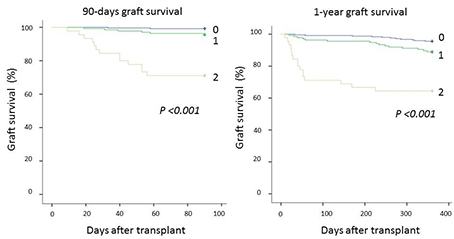Lactate/platelet Ratio after Liver Transplantation; a Novel Predictor for Short-Term Graft Failure
1Surgery, University of Tsukuba, Tsukuba, Ibaraki, Japan
2Transplant, Henry Ford Hospital, Detroit, MI.
Meeting: 2018 American Transplant Congress
Abstract number: A238
Keywords: Graft failure, Graft-versus-host-disease, Liver transplantation
Session Information
Session Name: Poster Session A: Liver Retransplantation and Other Complications
Session Type: Poster Session
Date: Saturday, June 2, 2018
Session Time: 5:30pm-7:30pm
 Presentation Time: 5:30pm-7:30pm
Presentation Time: 5:30pm-7:30pm
Location: Hall 4EF
Background; Recently, platelet count and lactate level after liver transplantation (LT) have been both separately reported as predictors of graft failure. In this study, we discovered a novel combination of these two parameters, “lactate level immediately post-LT (mmol/L)/platelet count on postoperative day 5 (x 1,000/uL) ratio (LPR)” to predict short-term graft failure. Method; We retrospectively reviewed 434 deceased donor LT between January 2008 and December 2014. Using ROC analysis, cutoff values of LPR immediately post-LT for 90-days graft survival were determined. Risk factors for graft failure at 90-days and 1-year post-LT were analyzed by Cox regression model. Further, risk factors for high LPR combined with early allograft dysfunction (EAD) were determined by logistic regression model. EAD was defined as a peak values of aminotransferase>2000 IU/mL during the first week or an international normalized ratio≥1.6 and/or bilirubin≥10 mg/dL at day 7. Results;Cut-off value for LPR to predict 90-day graft loss was 0.12 with AUC of 0.80 (sensitivity 71% and specificity 79%). On multivariate analysis, reoperation within 30 days (HR =2.97, P =0.03), EAD (HR =5.80, P =0.003) and LPR >0.12 (HR =3.99, P =0.01) were independent risk factors for 90-days graft failure. Also, reoperation within 30 days (HR =2.15, P =0.02), EAD (HR =2.91, P =0.001), and LPR >0.12 (HR =2.41, P =0.01) were independent risk factors for 1-year graft failure. Scoring system using EAD (0 or 1) and high LPR (0 or 1) stratified 90 days and 1 year graft survival (P <0.001,  ). Reoperation within 7 days (Odds ratio [OR] =7.24, P <0.001), liver donor risk index >1.70 (OR =2.92, P =0.02), and warm ischemia time >45 minutes (OR =2.26, P =0.04) were considered independent risk factors for EAD with high LPR (>0.12). Conclusions; Our results suggested that high LPR (>0.12) might be a reliable predictor for early graft failure after LT, especially combined with EAD. Further investigation is warranted to elucidate the clinical implication of LPR.
). Reoperation within 7 days (Odds ratio [OR] =7.24, P <0.001), liver donor risk index >1.70 (OR =2.92, P =0.02), and warm ischemia time >45 minutes (OR =2.26, P =0.04) were considered independent risk factors for EAD with high LPR (>0.12). Conclusions; Our results suggested that high LPR (>0.12) might be a reliable predictor for early graft failure after LT, especially combined with EAD. Further investigation is warranted to elucidate the clinical implication of LPR.
CITATION INFORMATION: Takahashi K., Nagai S., Safwan M., Collins K., Rizzari M., Yoshida A., Ohkohchi N., Abouljoud M. Lactate/platelet Ratio after Liver Transplantation; a Novel Predictor for Short-Term Graft Failure Am J Transplant. 2017;17 (suppl 3).
To cite this abstract in AMA style:
Takahashi K, Nagai S, Safwan M, Collins K, Rizzari M, Yoshida A, Ohkohchi N, Abouljoud M. Lactate/platelet Ratio after Liver Transplantation; a Novel Predictor for Short-Term Graft Failure [abstract]. https://atcmeetingabstracts.com/abstract/lactate-platelet-ratio-after-liver-transplantation-a-novel-predictor-for-short-term-graft-failure/. Accessed December 19, 2025.« Back to 2018 American Transplant Congress
